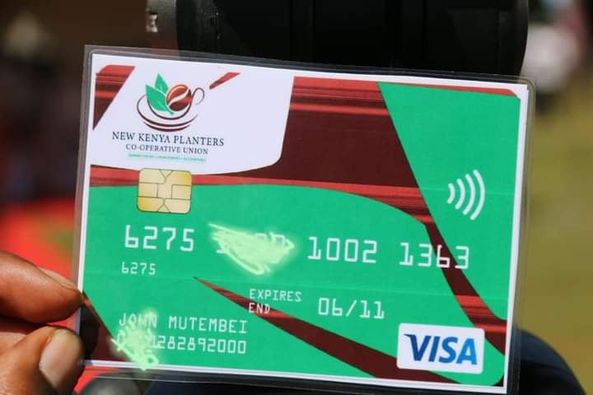State aims to boost national average coffee production from 2kgs per tree to 5kgs, increasing coffee growers’ gross earnings per year by 50%.
Agriculture CS Hon Peter Munya has launched the Coffee Farm Inputs Stimulus Package E-subsidy Programme in Nyeri and Kirinyaga counties. The programme aims to promote a sustainable increase in income among the coffee growers through improved productivity.
Implementing the program will boost national average coffee production from 2kgs per tree to 5kgs, increase coffee growers’ gross earning per year by 50%, and improve the quality of coffee premium grades produced from the current 70% to 90% by 2024.
The programme will allow coffee farmers to access a wide range of inputs of their choice at the required time and at the nearest input supplier through an e-voucher system.
Smallholder coffee farmers in cooperative societies and small estate coffee farmers holding less than 20 acres of land under coffee are eligible to join the programme.
The government has identified input suppliers who will be involved in the programme, like Agro-dealers and Cooperative societies that issue inputs. A farmer will be issued with a card that they will use to buy fertilizer or pesticides from accredited suppliers.
The farmer will swipe the card at the accredited agro-dealer and pay 60% of the input cost, and the government will give a 40% subsidy.
Munya told coffee farmers in Nyeri recently that the subsidy programme will help farmers increase their production and lower their cost of production. Farmers at the meeting had raised concerns over the high cost of inputs.
He also said the ministry worked with Kenya Plant Health Inspectorate Service (KEPHIS) to conduct tests on pesticides to ensure they were up to the required standards before being sold to farmers. He said this was necessitated by complaints from farmers on the quality of some pesticides being sold to them, leading to losses.
New KPCU Former Chairman Henry Kinyua said the e-voucher system has three components: the administrator, the bank or banks, participating farmers, and the participating supplier agro-dealers.
The administrator registers all participants and uses the data to design how beneficiaries will access the inputs and pay suppliers.
New KPCU, a government parastatal, is the fund’s administrator in this program, and Ksh 1 billion is in their account. The Cooperative Bank is the main Banker in the program. All participating farmers and agro-dealers are expected to register with New KPCU. The bank will use the data to issue farmers with a card resembling an ATM.
All registered agro-dealers will be given a gadget like a PDQ machine that they will use to validate the cards.
So suppose a farmer in Karatina or Kipkelion wants to buy a fungicide worth KSh 100. The farmer will go with their card to Karatina Agro-shop or Kipkelion cooperative agro shop, assuming they are registered to swipe the card, pay Ksh 60 and get the fungicide. By swiping the cards, the Agro-shops will activate the bank to release the Ksh 40 to their accounts.
“Unlike in previous programs where government entities such as NCPB used to procure all inputs in bulk and distribute, this e-voucher program benefits local businesses, and even farmer-owned agro-shops can register and be part of the program,” said Kinyua.
Coffee Revitalization Programme
Despite many interventions to support the coffee industry, there has been a steady decline of production from 129,637 MT CC in 1988 to 36,873 MT CC in 2020.
Land under coffee production has equally dropped from 153,030Ha to 119,675Ha during the same period. Weak enforcement of policies and regulations in the coffee industry also contributed to the decline.
The coffee revitalization programme seeks to expand coffee production, adopt improved coffee varieties, increase affordable/subsidized farm inputs, and train farmers on best agricultural practices. The programme’s overall goal is to promote a sustainable increase in income among the coffee growers through improved productivity.
The current national production average is 2kgs per tree with Coffee Directorate records.
Current production per county is as follows:
County Production per tree in Kgs
1 Nyeri 2.5
2 Muranga 2.0
3 Kirinyaga 4.0
4 Embu 2.0
5 Tharaka Nithi 1.5
6 Meru 2.0
7 Kiambu 2.0
8 Machakos 1.5
Available figures indicate that Kenya earned more from coffee exports despite a fall in quantity exported.
Kenya earned $ 213 million between January- November 2021, compared to $ 196 million in 2020, the Kenya National Bureau of Statistics (KNBS) said.
During the 2021 trading period, Kenya’s coffee prices ranged from 4 dollars to 6.3 dollars, up from 2.5 dollars to 5.9 dollars in 2020, according to KNBS. However, despite the rise in earnings, the quantity of coffee exported fell as production shrunk for the second year running.
Kenya exported 35,163 metric tons (MT) of coffee in the first 11 months of 2021, a fall from 40,980 MT over the same period in 2020.
Kenya exports an average of 2,500 MT of coffee a month. However, this figure has dropped as farmers abandon coffee for other crops such as macadamia and avocado while others sell their farms to real estate developers.
Kenya is considered the 5th largest producer of coffee in Africa after Ethiopia (7.38 million 60 kg bags), Uganda (5.62 million bags), Cote d’Ivoire (1.78 million bags) and Tanzania (913,000 bags).
Figures from the International Coffee Organization show that Kenya produces an estimated 800,000 bags annually.
Source: Co-op News Team and www.kilimonews.co.ke





